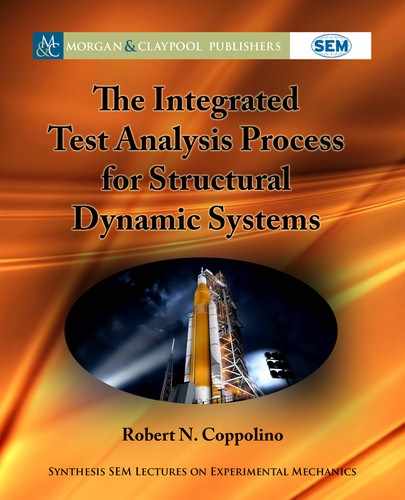
4.1. PART 1: PRELIMINARY MEASURED DATA ANALYSIS 67
p.z/ D
n
z
max
z
min
h.z/
N
: (4.4)
e ideal normalized Gaussian probability density function, p
G
.z/, is defined as [1];
p
G
.z/ D
1=
p
2
e
.z
2
=2/
: (4.5)
Both the actual normalized probability density and normalized Gaussian probability den-
sity functions have the integral property [1]
1
Z
1
p.z/dz D
1
Z
1
p
G
.z/dz D 1: (4.6)
4.1.4 TOTAL NORMALIZED PROBABILITY FUNCTION
e total probability that the normalized time history will fall within a specified range is defined
as [1],
P .z
1
z z
2
/ D
z
2
Z
z
1
p.z/dz; (4.7)
and the probability that the value of z will not exceed an upper bound, z
2
, is defined as
P .1 z z
2
/ D
z
2
Z
1
p.z/dz: (4.8)
4.1.5 AUTOSPECTRUM OR POWER SPECTRAL DENSITY FUNCTION
e autospectrum or power spectral density function is defined in the literature by a variety of
relationships. For a thorough exposition of this function [1], a physically descriptive definition
of the autospectrum is based on the way this quantity was estimated prior to the popular use of
digital signal processing techniques. e analog process for estimating autospectrum involved
four steps.
1. Filter a time history, x.t /, with a narrow bandpass filter of bandwidth, f , and center
frequency, f (Hz), resulting in x.f; f; t/.
2. Form the square of the filtered signal, x
2
.f; f; t/.
3. Calculate the average value of the squared, filtered signal,
Nx
2
.f; f; t/ D
1
T
T
Z
0
x
2
.f; f; t/dt: (4.9)

68 4. MEASURED DATA ANALYSIS
4. Divide the result by the filter bandwidth, f , resulting in the autospectrum (or power
spectrum),
G
xx
.f / D
Nx
2
.f; f; t/
f
D
1
.
f T
/
T
Z
0
x
2
.f; f; t/dt: (4.10)
e (real-valued) autospectrum provides information on the frequency distribution of the
standard deviation of a time history record. It therefore has the following property:
2
D
1
Z
0
G
xx
.f /df : (4.11)
A modern digital, state-of-the-art method for calculating the autospectrum employs the
finite Fourier transform of the time history record. By subdividing the record into “n
d
” distinct
sub-records or “windows” (of duration, T ) the autospectrum is defined as,
G
xx
.f / D
2
.n
d
T /
n
d
X
iD1
X
i
.f / X
i
.f /: (4.12)
X.f / is the finite Fourier transform of the time domain series, x.t /, where the temporal sam-
pling rate is t. e autospectrum, G
XX
.f /, is calculated at discrete frequencies, f
k
D k f ,
where 0 k n
w
=2. Important guidelines for computation of an appropriate autospectrum are:
f
max
D
1
2 t
(Nyquist frequency); f D
1
T
(bandwidth resolution)
n
w
D
T
t
(discrete Fourier transforms “window” length)
T
max
D n
d
T (total record length for “n
d
” distinct averages):
(4.13)
In practice, the originally measured “analog” signal, x.t/, should be low-pass filtered with
a “cut-off” frequency (typically 0:8 f
max
) in order to avoid aliasing before conversion to a time
series with digital bandwidth, f
max
. In addition, a sufficiently long data record, T
max
, should be
recorded to estimate an autospectrum associated with a desired bandwidth resolution, f , and
number of distinct averages, n
d
(typically in excess of 10 to minimize contributions associated
with extraneous noise sources). It should finally be noted that specialized “windowing” functions
and correction factors (e.g., the Hanning window and “bow-tie” correction factors) and overlap
processing (non-distinct successive records) are commonly applied practices [1].
..................Content has been hidden....................
You can't read the all page of ebook, please click here login for view all page.
